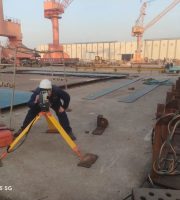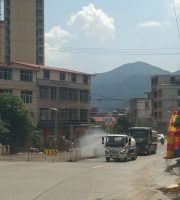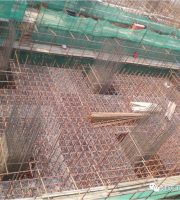” 2.
In the mixing process of concrete, if the mixing is uneven, the same water cement ratio will make the admixture less evenly distributed, and more bubbles will be generated in the surplus part of the admixture, while the part that is not mixed with the admixture will have uneven slump, large slump loss, segregation and other phenomena, but excessive mixing will cause more and more bubbles to be formed in the mixing process of concrete, resulting in negative effects.
It should be noted that the air content in the concrete is appropriate, and the micro bubbles have a certain stability in the concrete construction process under the conditions of uniform distribution and closed and independent.
The formwork shall be kept bright and clean, and the release agent shall be applied evenly, but not too much or too thick.
Once there are bubbles in the concrete, they will be adsorbed on the formwork and formed on the surface of the concrete structure.
01 bubble category bubbles generated in concrete, 100 μ Those above M are called harmful bubbles, 100 ~ 50 μ M is called medium harmful bubble, 50 ~ 20 μ M is called low harm bubble or harmless bubble, 20 μ Those below m are called beneficial bubbles.
From the two aspects of the height and time of layered vibration, the higher the height of layered vibration is, the more difficult it is for bubbles in the concrete to be discharged.
3.
2.1 effect of mixing time on bubble formation mixing time also has different effects on bubbles generated in concrete.
03 bubble control and prevention and improvement measures for raw materials 1.
It is suggested that the construction unit should pay attention to the vibration process.
Copyright statement: This article is from China’s commercial concrete Wang Yu.
If the cement dosage is increased on the premise of meeting the concrete strength, so as to reduce the water cement ratio, the amount of bubbles will be greatly reduced.
In the concrete trial mix, the cement dosage is mainly considered for the strength.
2.
This waste engine oil has strong adsorption on bubbles.
Cement and water consumption are also important reasons for bubbles.
Generally, air entraining agent with certain air entraining components may be added to water reducing agent or composite pumping agent, and the amount of water reducing agent will increase, and the bubbles will also increase.
02 causes of bubbles 1.1 influence of cement on bubble formation using grinding aids in the process of cement production will usually produce too many bubbles, and the alkali content in cement is too high, the fineness of cement is too fine, and the air content will also increase.
Theoretically speaking, the gap formed by such tiny bubbles belongs to the range of pores, or harmless pores and less harmful pores.
Construction technology 1.
It is often the waste engine oil recovered from the machinery factory.
3.
The vibration operation shall be carried out in strict accordance with the operation mode of “fast insertion and slow extraction”, and the phenomenon of under vibration, missing vibration and over vibration of concrete shall be strictly prevented.
For aggregates, the material shall be well controlled, the particle size grading and the content of needle and flake particles of aggregates shall be strictly controlled, and the materials shall be carefully screened and unqualified materials shall be removed.
According to “7.5.2” of ready mixed concrete gb/t14902, the mixing time of each plate during mixing production (calculated from the completion of all materials) shall not be less than 30s.
It is required to “insert quickly and pull out slowly”, that is, the insertion speed should be fast, so that the upper and lower concrete are vibrated almost at the same time, and the pulling out should be slow, otherwise the position of the vibrator is not easy to be filled and form a gap, which is not conducive to the discharge of bubbles.
During the construction of concrete, it should be distributed and vibrated in layers.
It is only for learning and exchange.
The super vibration will cause the tiny bubbles in the concrete to burst and reorganize under the mechanical action, from small to large.
In addition, attention should be paid to the adaptive selection of mold release agent in combination with the type of template, so that the combination can reduce the amount of bubbles.
If there is infringement, please contact to delete it…
The user should advise the admixture manufacturer to strictly control the dosage when preparing the admixture.
It is suggested that the construction unit should choose high-quality release agent and check whether the template and release agent used match.
Both under vibration and leakage vibration will make the concrete appear non dense, resulting in natural cavities in the concrete or irregular large air bubbles.
Select reasonable aggregate gradation and sand ratio.
The plugging speed of the vibrator will also affect the discharge of bubbles.
Pay attention to the mixing time, so that the admixture can be fully and evenly mixed with other raw materials.
As a concrete structure, the better the vibration is, the denser the internal structure of the concrete will be.
2.3 influence of vibration on bubble formation due to different vibration environments during construction, the operation of vibrators also has different effects on the number of bubbles on the concrete surface.
The thickness of the layer should be no more than 50cm, otherwise it is not easy for bubbles to discharge upward from the inside of the concrete.
However, the appearance of over vibration, under vibration and leakage vibration will cause more and more bubbles on the surface of concrete.
2.2 the influence of the selection of release agent on the formation of bubbles.
It will not only not reduce the strength, but also greatly improve the durability of concrete.
There are also standard requirements for mixing time.
Its function is to use excess mortar to fill the remaining gap, so as to block the formation space of bubbles.
1.3 the influence of coarse and fine aggregate on the formation of bubbles according to the principle of dense grading of granular materials, during the construction process, the material grading is unreasonable, the coarse aggregate is too much, the size is improper, the content of needle and flake particles is too much, and the actual sand rate used in the production process is smaller than the sand rate provided by the laboratory, so the fine aggregate is not enough to fill the gap of coarse aggregate, resulting in the incompleteness of granular material and the formation of free gap, which provides conditions for the generation of bubbles.
1.2 the influence of admixtures on the formation of bubbles, such as the large number of bubbles in concrete, may usually be related to the poor air entraining composition in admixtures.
Pure oil release agent will still be used by some construction units.
It is recommended to give priority to cement with less bubbles and low alkali content.
When preparing concrete with strength grade above C50 or using air entraining agent, expansion agent and waterproof agent, the mixing time should be increased.



